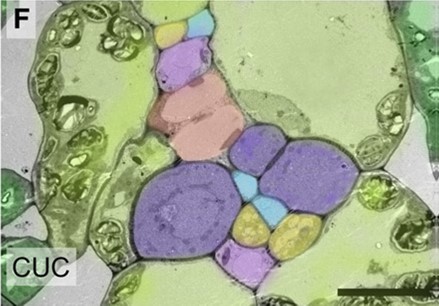Sugars produced by photosynthesis in leaves are distributed by special cells of the phloem into all plant organs. This paper studies structurally and functionally the transport pathway from the photosynthetic active leaf cells to the phloem. Responsible are cell-to-cell contacts called plasmodesmata. Using transmission electron microscopy, the number and width of plasmodesmata at the relevant interfaces is compared for nine different plant families, including herbaceous as well as tree species. The study concludes that the structure and function of plasmodesmata at the bundle sheath–companion cell interface (light green and violet shaded, respectively) allow to anticipate whether sugars enter the phloem directly via plasmodesmata or need to cross the plasma membranes of these cell types using specific membrane carriers.

Electron micrograph of a minor vein of pumpkin leaves. Blue-green: photosynthetic active mesophyll cells, light green bundle sheath cells, violet companion cells, blue sugar-transporting sieve elements, orange xylem elements, yellow phloem parenchyma cells.

